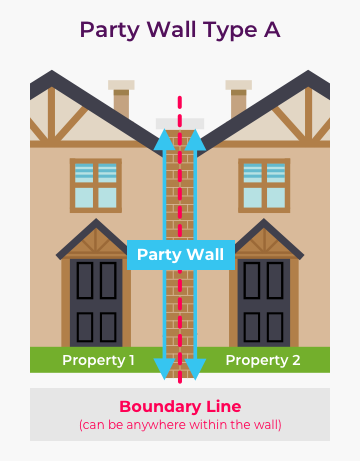What is a Party Wall?
A Party Wall is a shared wall between two or more adjoining property owners. If you want an extension or any work on your home that involves the party wall, you will usually need to notify any affected neighbours.
The Party Wall etc. Act 1996 protects the rights of everyone involved regarding work on a dividing wall. This covers the notice given to neighbours, your responsibility towards them and who is liable for the costs. It also covers what work can take place and how it should be carried out.
If an agreement cannot be made between neighbours, a surveyor will usually need to draw up a Party Wall Agreement.
Be aware that the Act does not apply in Scotland and Northern Ireland. Instead, common law is used to settle party wall issues.
- Examples of Party Walls
- The Party Wall etc. Act 1996
- What Work is Notifiable Under the Act?
- What Building Works are Not Notifiable
- Serving a Party Wall Notice
- What Happens After Serving a Notice?
- Disputes with Adjoining Neighbours
- What Rights Do Adjoining Owners Have?
- What is a Party Wall Agreement?
- Do I Need a Party Wall Surveyor?
- How Much are Surveyor's Fees?
Examples of Party Walls
A Party Wall can either be:
- Type A: A wall which sits across two or more homeowner's land
- Type B: A wall which is wholly on one homeowner's land, but is used by a neighbour to separate their property from yours
The main types of Party Walls include:
- An adjoining wall in terraced or semi-detached houses (including chimneys)
- A common wall in a garage or outhouse
A "Party Fence Wall" is not part of the building but still sits astride the boundary between two homeowners. An example of this is a masonry garden wall. Wooden fences or concrete posts and timber panels are not covered by the 1996 Act.


Save on Your Party Wall Survey
Speak to a RICS or RPSA Surveyor Today
The Party Wall etc. Act 1996
The Party Wall etc. Act 1996 assists both the homeowner who proposed the work and any adjoining owners. It is an enabling act meaning its purpose is to allow work to go ahead, not to prevent it. It provides protection and guidelines for all parties involved.
The Act was created to avoid and help settle disputes between neighbours on Party Wall matters.
What Work is Notifiable Under the Act?
The Act provides the “Building Owner” (who wants work done) with rights beyond ordinary common law rights. If you intend to have any of the following done, you must inform any adjoining owners.
Some common works include:
- Repairing the party wall
- Extensions that impact the party wall
- Inserting a damp-proof course
- Underpinning the party wall
- Cutting into the party wall, e.g. - to take the bearing of a beam
- Raising the height of a party wall
- Extending a party wall downwards
- Demolishing and rebuilding a party wall
- Cutting off projections from the party wall (for example, a chimney breast)
What Building Works are Not Notifiable
Minor work such as putting up wall units, shelving, pictures or mirrors is not usually notifiable. You may also drill into your own half of the wall to access, add or replace recessed electric wiring, sockets and light fittings. Replastering and skimming within your home on the party wall can also be done.
If you are in doubt about what is covered under the Party Wall Act, it may be worth contacting a surveyor for advice.
Serving a Party Wall Notice
You must serve a Party Wall Notice to your neighbour, referred to as the "Adjoining Owner", before any notifiable work takes place. This is a document outlining the work you want to take place.
There are three notice types which include:
- Section 1 – Line of Junction (one month’s notice)
- Section 2 – Party Structure Notice (two months’ notice)
- Section 6 – Adjacent Excavation (one month’s notice)
The notice can be delivered in person or by post. If the recipient agrees, it can also be sent electronically. You can complete the notice yourself or pay a flat fee to a Party Wall surveyor to prepare the document for you. Be aware that a notice is not the same as a Party Wall Agreement.
Planning permission is not required to serve a party wall notice.
Save on Your Party Wall Survey
Speak to a RICS or RPSA Surveyor Today
What Happens After Serving a Notice?
After you serve a notice, your neighbour has fourteen days to respond. They can either:
- Agree to the proposed works and accept the notice
- Dispute or reject the notice and proposed works
- Serve a counter notice with changes or requests
- Ignore the notice or not respond within the notice period. In this case, it would be deemed to be disputed
Disputes with Adjoining Neighbours
If the adjoining owner disputes the Party Wall notice, it is at this point you should look at hiring a surveyor. However, it is recommended that you try to settle the matter amicably with the adjoining homeowner.
Settling this early on will not just save you money on a surveyor. Keep in mind that you will be living next door to your neighbours, perhaps for some time. With this in mind, it is worth keeping the matter friendly and civil.
What Rights Do Adjoining Owners Have?
Adjoining owners have the right to:
- Appoint a surveyor to resolve a dispute
- Require necessary measures to be taken to protect their property from damage
- To not be caused unnecessary inconvenience
- To be compensated for any loss or damage caused by the works
- To ask for security for expensive before the work starts to guard against the work stopping at an inconvenient stage, causing them to be left in difficulties
Save on Your Party Wall Survey
Speak to a RICS or RPSA Surveyor Today
What is a Party Wall Agreement?
A Party Wall Agreement is a legally binding document which is drawn up by a surveyor. This is also known as a Party Wall Award and is a crucial part of the dispute resolution process. If you want to carry out any work which is notifiable under the Party Wall Act then you may need one of these.
The agreement outlines proposed works and obligations to neighbours and their properties. It will cover alterations that may directly impact neighbouring buildings. It will also detail any excavations within six metres from the boundary if the neighbour’s property may be affected.
The agreement will detail the costs involved, including surveying costs. It will also note who is responsible for paying. The Agreement can be appealed by an adjoining owner but this must be done in a County Court within 14 days of it being served.
Do I Need a Party Wall Surveyor?
If a neighbour has disputed or ignored your Party Wall notice, you must appoint a surveyor. They can inspect the Party Wall in question and review the intended work. They can then draw up a Party Wall Agreement. You can also instruct the surveyor to provide the initial Party Wall notice.
If you can come to an agreement with your neighbour in the early stages of the process, you may not need a surveyor. This can save you both time and money. However, a surveyor can help settle Party Wall disputes, ensuring the situation does not escalate.
Be aware: You cannot act as your own surveyor.
By using Compare My Move, you can get connected with up to 6 RICS or RPSA party wall surveyors. This allows you to find the best surveyor for your Party Wall matter.
How Much are Surveyor's Fees?
Party Wall Surveyors often charge an hourly rate and the hourly rate in the UK is on average between £90 and £450.
On average, Party Wall Surveyor costs are around £1,000. Your final bill will depend on your surveyor's fees and how long they spend assessing your case. It will also depend on how long it takes to create the Party Wall Agreement.
For more information read: How Much Are Party Wall Surveyor Costs?

